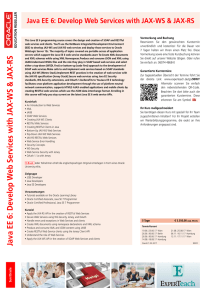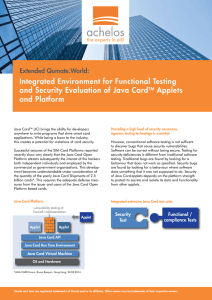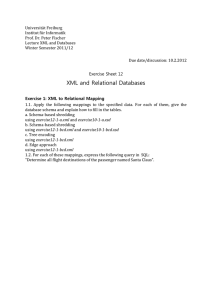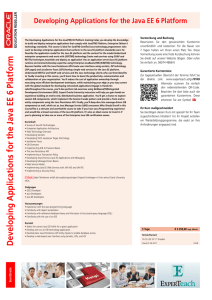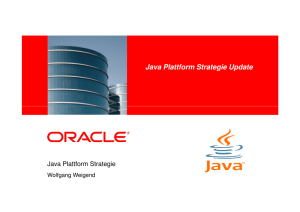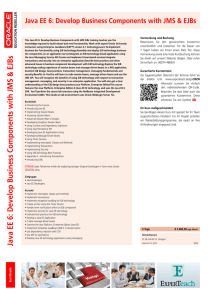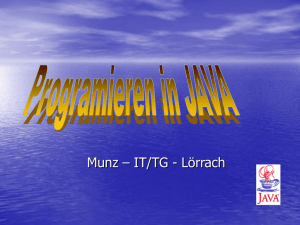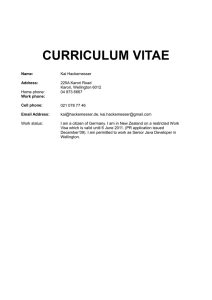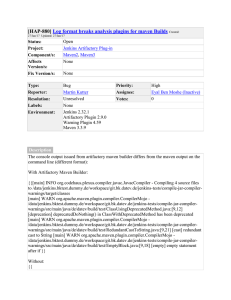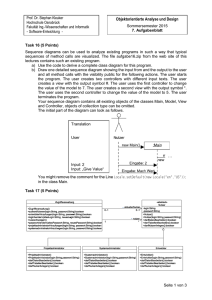JPA-RS - JUG Ostfalen
Werbung
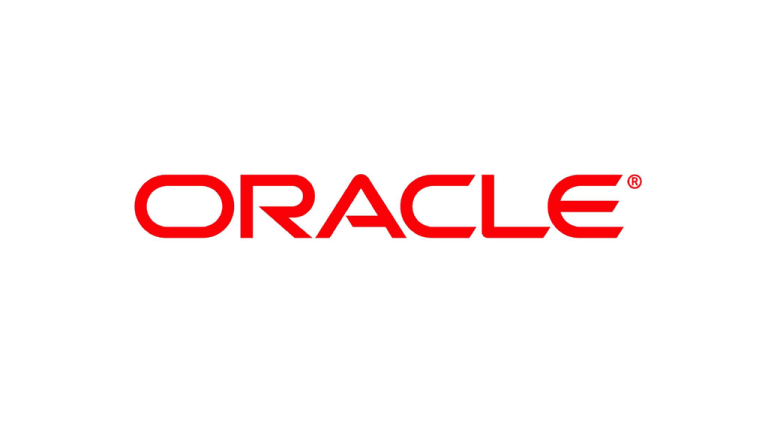
Java Persistence and More Michael Bräuer Oracle Deutschland B.V. & Co. KG The following is intended to outline our general product direction. It is intended for information purposes only, and may not be incorporated into any contract. It is not a commitment to deliver any material, code, or functionality, and should not be relied upon in making purchasing decisions. The development, release, and timing of any features or functionality described for Oracle ’ s products remains at the sole discretion of Oracle. Java Application Server Plattform Community Eine Community von ORACLE für Kunden, Partner und Interessierte Code Camps Demos GlassFish Server Java EE Community Treffen Vorträge Administration Registrierung: Blog: Ansprechpartner: WebLogic Server JSRs Serverseitige Entwicklung Wissensaustausch https://www.xing.com/net/oraclejavaappserver http://fmwtech.wordpress.com [email protected] [email protected] Java EE Hackaton Tagesveranstaltung http://fmwtech.wordpress.com/2013/10/23/java-ee-hackaton-fur-devops-anmeldung-jetzt/ Agenda Java EE 7: JPA 2.1 Trends of Java Persistence (with EclipseLink) Java EE 7 JPA 2.1 Java Persistence API Standardizing Java Persistence JPA 1.0: May 2006 JPA 2.0: December 2009 JPA 2.1: Juni 2013 Java Persistence API Java Persistence API 2.1 Highlights Schema Generation – javax.persistence.schema-generation.* properties Unsynchronized Persistence Contexts Query Enhancements, e.g. – Bulk update/delete using Criteria – User-defined functions using FUNCTION – Stored Procedure Query, etc. Converter Entity Graphs Java Persistence API 2.1 Entity Graphen Ergänzungen Nachladen von Attribut-Knoten, die nicht Teil des ursprünglichenEntityGraphen waren: in Eclipselink wird das Attribut bei Bedarf nachgeladen (lazy loading) Java Persistence API 2.1 Examples Look at https://bugs.eclipse.org/bugs/show_bug.cgi?id=415742 http://wiki.eclipse.org/EclipseLink/Release/2.5/JPA21 Java EE 8 and Beyond Caching NoSQL JSON-B HTML5++ Modularity Java EE 7 State Management PaaS Cloud Java Persistence mit EclipseLink Customer id: int name: String creditRating: int Java JPA CUST ID NAME C_RATING Relational EclipseLink: more than JPA Customer id: int name: String creditRating: int Java JPA CUST ID NAME C_RATING Relational JAXB <customer id=“…”> <name>…</name> … </customer> XML EclipseLink : more than JPA Customer id: int name: String creditRating: int Java JPA CUST ID NAME C_RATING Relational JAXB “JSON-B” <customer id=“…”> <name>…</name> … </customer> { id=“…” name =“…” … } XML JSON EclipseLink : more than JPA Customer id: int name: String creditRating: int “JSON-B” Java JPA @NoSQL CUST ID NAME C_RATING Relational JAXB NoSQL <customer id=“…”> <name>…</name> … </customer> { id=“…” name =“…” … } XML JSON EclipseLink Project Java SE JPA Java EE MOXy OSGi DBWS ... Databases XML , JSON Legacy Systems EclipseLink www.eclipselink.org Links: http://git.eclipse.org/c/eclipselink/ – GIT Runtime, Examples etc. Docs: http://www.eclipse.org/eclipselink/documentation/ EclipseLink vs. TopLink TopLink ships EclipseLink support.oracle.com, Notes: 1392592.2, 1069115.1 TopLink also includes TopLink Grid (Coherence and JPA), TopLink Data Services Now Some Code Demos on ... Standards Relational • JPA 2.1 XML • JAXB 2.2 • SDO 2.1.1 DBWS • JAX-WS Recent Future • JSON Binding • Dynamic JPA • JSON-B • Java Standard for NoSQL? • Tenant Isolation • RESTful JPA • NoSQL JSON Binding JSON Binding / EclipseLink “JSON-B” Provides Java-JSON binding similar to EclipseLink JAXB’s Java-XML binding Marshall Java domain model to and from JSON Currently no Java standard—EclipseLink interprets JAXB XML bindings for JSON Content-type selectable by setting property on Marshaller/Unmarshaller EclipseLink JSON-B Goals Offer the same flexibility as object-to-XML mappings Support both XML and JSON with one set of mappings No additional compile time dependencies over the JAXB APIs XML and JSON from JAXB Mappings XML JAXB mapped Java JSON Challenges – Mapping JPA Entities to XML <?xml version="1.0" ?> <employee> <first>Mark</first> <last>Twain</last> <id>1</id> </employee> JAXB JPA • Bidirectional/Cyclical Relationships • Composite Keys/Embedded Key Classes • Byte Code Weaving Bidirectional Relationship @Entity public class Project{ ... @OneToMany(mappedBy=“project") private List<Employee> members; } @Entity public class Employee{ ... @ManyToOne private Project project; } Bidirectional Relationships in JAXB JAXB specification does not support bidirectional relationships. One side must be marked @XmlTransient. But that loses the relationship! members Employee project Project <?xml version="1.0" ?> <employee> <first>Mark</first> <last>Twain</last> <id>1</id> </employee> Marshall Unmarshall X Employee project Project EclipseLink XmlInverseReference @Entity public class Project{ ... @OneToMany(mappedBy=“project") private List<Employee> members; } @Entity public class Employee{ ... @ManyToOne @XmlInverseReference(mappedBy=“members") private Project project; } EclipseLink XmlInverseReference EclipseLink restores relationships on unmarshall! members members Employee Project project Marshall <?xml version="1.0" ?> <employee> <first>Mark</first> <last>Twain</last> <id>1</id> </employee> Employee Unmarshall project Project JPA-RS JAX-RS with JPA Example – GET Invoice public class InvoiceService {... public Invoice read(int id) { return null; } ... JAX-RS with JPA Example – GET Invoice @Stateless public class InvoiceService {... public Invoice read(int id) { return entityManager.find(Invoice.class, id); } ... JAX-RS with JPA Example – GET Invoice @Path("/invoice") @Stateless public class InvoiceService {... public Invoice read(int id) { return entityManager.find(Invoice.class, id); } ... JAX-RS with JPA Example – GET Invoice @Path("/invoice") @Stateless public class InvoiceService {... @GET @Path("{id}") public Invoice read(@PathParam("id") int id) { return entityManager.find(Invoice.class, id); } ... JAX-RS with JPA Example – GET Invoice @Path("/invoice") @Stateless public class InvoiceService {... @GET @Path("{id}") @Produces({"application/xml", "application/json"}) public Invoice read(@PathParam("id") int id) { return entityManager.find(Invoice.class, id); } ... JAX-RS with JPA Example – GET Invoice @Path("/invoice") @Stateless public class InvoiceService {... @GET @Path("{id}") @Produces({"application/xml", "application/json"}) public Invoice read(@PathParam("id") int id) { return entityManager.find(Invoice.class, id); } GET http://[machine]:[port]/[web-context]/invoice/4 ... JAX-RS with JPA—High Level Architecture Client Java EE Server HTTP/S Offline db RDBMS JDBC JAX-RS with JPA Example JAX-RS Invoice Bean Contract Bean Payment Bean Accounting Persistence Unit JPA Accounting Application GET http://.../invoice/4 JAX-RS with JPA GET http://.../invoice/4 mapped to bean Invoice Bean Bean uses JPA JAX-RS Contract Bean Payment Bean Accounting Persistence Unit JPA Accounting Application JPA-RS GET http://.../jpa-rs/Accounting/Invoice/... JAX-RS JAX-RShttp://.../jpa-rs/Accounting/Invoice/... mapped to JPA-RS service JPA-RS JPA-RS maps URI http://.../jpa- Accounting PU rs/Accounting/Invoice/... to Accounting PU andHuman Invoice entityPU Contracting PU Resources ... JPA JPA-RS Features Access relational data through REST with JSON or XML Provides REST operations for entities in persistence unit (GET, PUT, POST, DELETE) Supports invocation of named queries via HTTP Server Caching—EclipseLink clustered cache Dynamic Persistence also supported – Entities defined via metadata—no Java classes required – Enables persistence services for HTML 5/JavaScript applications NoSQL Java Persistence NoSQL Databases NoSQL (i.e., non-relational) database are increasingly popular No standards Differing APIs and feature sets Some offer query language/API—some not EclipseLink NoSQL Support JPA-style access to NoSQL databases – Leverage non-relational database support for JCA (and JDBC when available) Define annotations and XML to identify NoSQL stored entities (e.g., @NoSQL) Support JPQL subset for each – Key principal: leverage what’s available Initial support for MongoDB and Oracle NoSQL. Support mixing relational and non-relational data in single composite persistence unit
